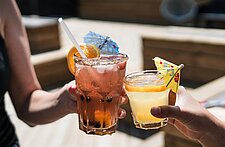Zhá Pan Asian brings delicious Asian creations from its permanent location at Broadway Bites, the culinary pop-up market in Greeley Square Park, near the famous Herald Square in Manhattan. Steven Luw, who grew up in Chinatown and made a name for himself in the Street Grub Everyday food truck community, operates Zhá Pan Asian, along with his friend, Heezy Lee. Emanuel Laroche, Vice President, Marketing & Consumer Insights, Symrise North America, Global Marketing Leader, interviewed Steve to gain insights into the impact of food trucks, carts and stands on the food and beverage industry.
E. L. Thanks for joining us today. I’d like to begin by asking you about when you began cooking. Do I understand correctly that your interest began at a very young age?
Steve Yes, I started to cook out of necessity when I was about 8 or 9 years old. I have two younger siblings who are five and six years younger than I am, and I was always at home with them, by ourselves. I had to do the cooking because my parents were working so hard. I would make things like sandwiches or whatever food happened to be around. But it wasn’t until I was about 11 or 12 that I realized how much food can impact people emotionally. My mother had always liked sushi so before going to Google and going on line to see what it looked like, I recalled what I had seen watching television. I used these little seaweed papers and I rolled up a piece of sushi for my Mom. I’m pretty sure it didn’t taste as good as she played it out to be, but I think that’s when I began to see there was something about food that can create a kind of emotional feeling and I fell in love with cooking.
E. L. So, how come you didn’t go into a food-related business initially?
Steve Actually I went to college for writing. I thought I would be a screen writer. I love to write but I got into the corporate world where I never wrote anything. It wasn’t until after eight years of working that I decided to take two months off from work just for the purpose of writing. This was in 2012 and I wanted to write something that people would read. So combined with an interest in food, I was led to writing a food blog. The blog was called Street Grub Everyday. I ate nothing but street food from food carts and stands for thirty whole days. I just wanted to detail my experiences . I wanted to see how it would affect me – would I get sick? There was this very big stigma about any and every kind of street food – being dirty or unhealthy and even not that delicious. I wanted to prove everybody wrong about this. I wanted to prove myself wrong. At the end of the thirty days, I had eaten at over 200 food trucks and street carts in New York City. I never ate anything at home, just from the trucks and carts. The result was that I was really drawn to the families and the people behind the food trucks. It wasn’t just hot dogs and pretzels and things that people associate with street food in New York City. There is a lot of delicious and amazing food that tells you about the people who create them. I completely fell in love with the food truck concept and decided I wanted to open one myself.

E. L. How did you come up with combining Asian with Italian as in the rice balls?
Steve Well, my best friend is Italian and I grew up with an adopted ‘Nonna’ and I enjoyed a lot of Italian. I also spent some time in Italy and had a lot of arancini – in Italian, that means ‘little oranges’ – since the little rice balls look like tiny oranges. Arancini are originally from Sicily although I had them in Naples. When I returned from Italy, I decided to embark on my food truck. I looked around and realized I had firsthand knowledge of all the food that was out there so I knew what my competition would be. I saw what was missing and what people needed. The arancini seemed a good idea – it’s something you can eat with one hand and you can put a lot of different flavors and ingredients in it. I began to ask myself why there were no Asian rice balls. I saw it as a blank canvas that would enable me to do anything with it. That’s when I began to develop these recipes and with my partner, Heezy, who was an Equities Trader, we tried out these recipes over the course of nine months. The first one was Chinese barbecue pork Asiancini. It was something that no one ever had before and we did a taste test where it achieved an 89 to 90 percent approval rating. We knew we had a green light. It was really nice to have something that looked like an Italian item but when you eat it, tasted like something new, while still having a nostalgic quality that is very comforting. I love it when customers come to me and tell me it’s the most ethereal and delicious thing they have ever had. That’s what keeps me going.
Fore more street food insights, CLICK HERE to subscribe to the in-sight newsletter!
E. L. How were you inspired to create the other items on your menu?
Steve I knew from the get-go that I needed to create things that were easy to understand but also different. None of my customers had ever had experienced an Asian rice ball but they came to understand it. The textural components were there. If you bite into it, there’s the crunch outside but inside it is soft and the flavors just knock you out. My inspiration came from the foods I ate and enjoyed when I was growing up. My business partner and I looked back on our childhood memories and everything we ate growing up , we just included in our offerings. Whatever works is what we sell.
E. L. In your opinion, why did you believe you received the Vendy Award?
Steve: Although Heezy and I are very confident in the foods we create, the Vendy Award was a complete surprise. The Vendy Award for the Best Market Vendor is celebrated in a few states but the New York City one has all the street food and market vendors competing – a few thousand in the city. The customers nominate entries and the top six get invited to the Vendy to battle each other. As I said, we knew our food is very delicious but recognized it was a new product. When we went there, we saw the Ramenburger and other familiar foods and food truck operators who had been in the business for a very long time and had a lot of loyal customers. I’ll be honest – we were scared and knew just by sheer volume that we would have fewer people waiting on line so we decided to go in with our two best flavors. When we saw people waiting on our line for an hour or so, I knew we had a chance. I think we won because our concept is entirely unique – there aren’t any other Asian rice balls. The experience of eating them turns many into being instantly addicted to them – they are so happy after having eaten it. I make it every day, and I’m telling you the truth, I eat it every day.

E. L. How do you see the food truck business evolving in time - in the next few years?
Steve As a New York City thing, there is a lot of ‘under the table’ money because the city tends to limit the number of licenses it issues. I’m not saying that these trucks are not legitimate but it’s a risky business and that’s what turned me off to it. But I see the food truck as having set a big trend and staying around for quite a while. There’s just no other place where customers have such a connection with the person preparing the food. When they go to a restaurant, they rarely meet the chef. They are more inclined to tell the food truck cook that their product is delicious or say they don’t like it. At any rate, there is a very intimate connection so even though it may be difficult to get a food truck in the New York City, I do believe they are here to stay.
CLICK HERE to view Street Food Interview Series: Coolhaus
E. L. How do you see your personal business evolving?
Steve In New York City, everyone is always in a rush to go somewhere. They have twenty minutes to eat. Some may consider my concept a ‘fast food’ - it takes me about 6 to 8 minutes to fry each order. For people who want to order something that tastes homemade and delicious and get it fast, my concept works. For me to grow the business now, I need to be indoors. I know you guys know that Anthony Bourdain is going to open a 50,000 square foot Food Hall in Chelsea by 2017 so there is a lot of interest in moving things indoors. Look, a lot of fast food chains are taking up the space in food halls, but in New York City you don’t find franchises like McDonald’s in fast food halls. You do find small, local food entrepreneurs there and I think customers love that. You go to a food hall and see 20 vendors that you may not have seen anywhere else at all and I think it will last.
E. L. In general, what do you see on the horizon for street food?
Steve Two to three years ago Asian fusion food was at its peak and it’s still around. I think that food trends tend to make chefs very creative. I see a trend in going back to basics. There are food trucks that I return to again and again because these are foods with familiar and delicious taste that go back 20 or 30 years. It’s likely to be what the chef’s mother or father made. I appreciate the food that tastes the same as it did when you were sitting down with your family and enjoying it. It doesn’t have to be creative – it just has to taste fantastic and give you a family feeling. I have a number of food trucks that I go to because of this quality – they are standouts to me.

E. L. Can you identify these for us?
Steve One of my favorites is Uncle Gussy’s which has been around since about 1979. They serve home-style, traditional food like their mother prepared – not necessarily creative but so delicious and they usually have a 45 minute wait. One of my favorite dessert trucks is Coolhaus, started by two ladies from California. They were architects. I know them and they have given me a lot of guidance. They make delicious ice cream sandwiches with tastes like chicken and waffles. They have taken something basic and made it super-super-cool. Another favorite of mine is Dig Deep Love Truck – they do a lot of Asian fusion foods, mixing Asian foods. I would love to take a tour of all the food trucks again. A lot of the owners know me as a buyer but not for my business. Food trucks are an opportunity for people who could never raise the capital to buy and open a restaurant. New York City is such a city so it’s great that there are these outlets for the owners and the people who go to them. A lot of owners like me have no experience in culinary schools, no formal training. But we do have a passion for food – that’s why I am happy.
CLICK HERE to view Street Food Interview Series: La Newyorkina
E. L. What do you see as the next big Street Food creation?
Steve I think old school traditional tastes will last and be perfected more and more by those who are making them every day. My Asiancini may be different but they are familiar, something that you want to eat every day. I see a trend for fusion and a trend for authentic food.
E. L. What are you working on as your next food item?
Steve I want to do more traditional meat roasts and Chinese barbecue. I have a Chinese, Japanese and Indonesian heritage, but it’s largely Chinese. I want to do a lot of things from scratch – I want to learn how to cut sides of raw meat – to start from the beginning. I think that is what makes you a better cook, doing every aspect of preparing the food you make. That’s how I plan to spend my winter – learning to be a butcher as well as making connections with food halls and will continue with the catering end of our business.
E.L. Thanks for all the information you shared with us. It’s been pleasure learning about you and your business.
Twitter: @ZhaPanAsian
Zhá Pan Asian
33rd Street and Broadway
New York, New York





